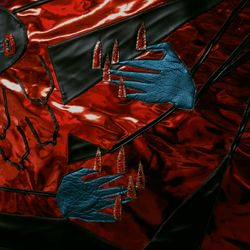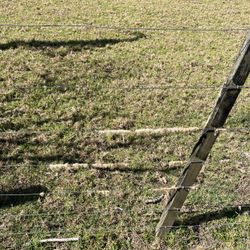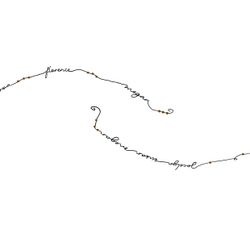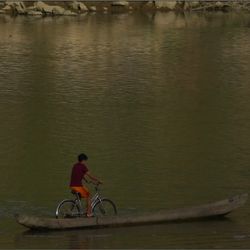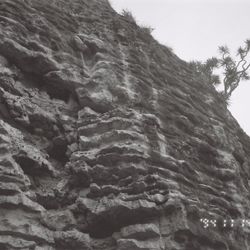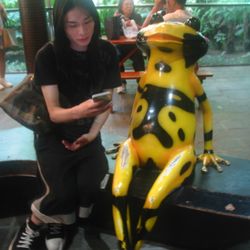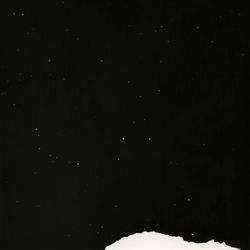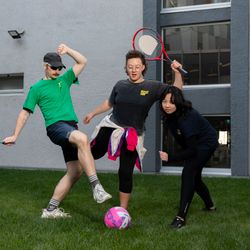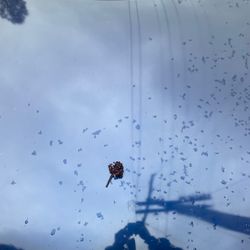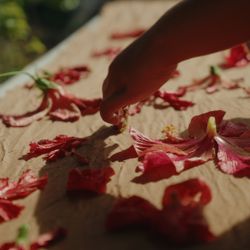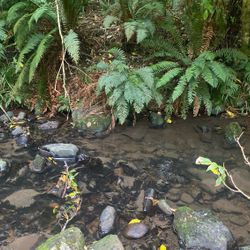Ka kore, Kua kore explores how pararopi-kore (inorganic waste) resulting from urban and rural pollution degrades te taiao, the natural environments that contain and surround us.
Past Exhibition
Hātarei 10 Hune -
Hātarei 15 Hūrae
Saturday 10 June -
Saturday 15 July
2023
Research image provided by Moewai Marsh.
Aidan Taira Geraghty’s sculptures are based on hīnaki, woven basket-like pots used in riverways and lagoons to catch tuna (eel). Geraghty has memories of eeling at the Waimakariri river mouth, and so hīnaki are a tangible reminder for him of his takiwā and māoritaka. Historically, the Waimakariri, Geraghty’s ancestral awa, was used by Kāi Tahu as mahika kai and as a route to access further, rich mahika kai lakes in the high country of Kā Pākihi-whakatekateka-a-Waitaha. More recently, run-off from industrial-scale bovine farming along the Waimakariri has caused massive damage to its sustainability as a mahika kai. The gnarly materials used to make the sculptures evoke how biohazardous waste and chemicals have entered waterways like the Waimakariri as a result of land use changes tied to colonisation. Compared to the meticulously woven hīnaki of old, these have an emaciated form, reflecting the breakdown of bodies of water that he and his whanauka hold kaitiaki over and all the taoka it provides.
Moewai Marsh has revisited working processes she developed for her work Tuturu exhibited as part of Paemanu: Tauraka Toi - A Landing Place at Dunedin Public Art Gallery. Whakaora, like Tuturu, is made from handmade paper and gathered whenua pigments and is conceptually guided by a commitment to whakapapa and kaitiakitaka. Marsh based Whakaora on fieldwork and research around Bethune’s Gully and Lindsay Creek near where she grew up with her grandparents under the summit of Kapukataumahaka. Lindsay Creek is a tributary of the Ōwheo, an awa that flows from remnant native cloud forest near Leith Saddle through north Ōtepoti to the harbour. The creek, before it joins the Ōwheo, connects with urban drains of the surrounding neighbourhoods of Pine Hill, Normanby and North East Valley. Healthy at its source, as the awa flows through urban areas it becomes paru, full of refuse such as road cones and glass, and confined by concrete channels. Marsh combines pararopi-kore with wood shavings, soil and leaves collected from around the awa in her papermaking process with painted tohu like toka tū moana, ripo moana and pātiki; the tohu being painted with earth pigments also harvested from Bethune’s Gully–whenua with an immediate connection to her tūrakawaewae. These tohu speak to the need for Lindsay Creek and the Ōwheo to be whakamārohirohi in their exposure to urban pollution.
So much mātauraka Māori has been lost. Land is in the hands of those who do not know how to look after it. Ka kore, Kua kore is our reminder to be kaitiaki for what we want to protect, our awa and the taoka it provides, our whenua and, most importantly, the knowledge of our tūpuna.
Installation view, 2023. Photo: Rosa Nevison
Moewai Marsh, Whakaora, Wood shavings, clay, kōkōwai, grass, leaves, bark, recycled paper, rubbish, 2023. Photo: Rosa Nevison
Moewai Marsh, Whakaora, Wood shavings, clay, kōkōwai, grass, leaves, bark, recycled paper, rubbish, 2023. Photo: Rosa Nevison
Aidan Taira Geraghty & Moewai Marsh, Tuna Heke, Greywacke, kōkōwai, 2023. Photo: Rosa Nevison
Aidan Taira Geraghty & Moewai Marsh, Tuna Heke, Greywacke, kōkōwai, 2023. Photo: Rosa Nevison
Moewai Marsh, Whakaora, Wood shavings, clay, kōkōwai, grass, leaves, bark, recycled paper, rubbish, 2023. Photo: Rosa Nevison
Moewai Marsh, Whakaora, Wood shavings, clay, kōkōwai, grass, leaves, bark, recycled paper, rubbish, 2023. Photo: Rosa Nevison
Moewai Marsh, Whakaora, Wood shavings, clay, kōkōwai, grass, leaves, bark, recycled paper, rubbish, 2023. Photo: Rosa Nevison
Installation view, 2023. Photo: Rosa Nevison
Moewai Marsh, Whakaora, Wood shavings, clay, kōkōwai, grass, leaves, bark, recycled paper, rubbish, 2023. Photo: Rosa Nevison
Moewai Marsh, Whakaora, Wood shavings, clay, kōkōwai, grass, leaves, bark, recycled paper, rubbish, 2023. Photo: Rosa Nevison
Moewai Marsh, Whakaora, Wood shavings, clay, kōkōwai, grass, leaves, bark, recycled paper, rubbish, 2023. Photo: Rosa Nevison
Moewai Marsh, Whakaora, Wood shavings, clay, kōkōwai, grass, leaves, bark, recycled paper, rubbish, 2023. Photo: Rosa Nevison
Moewai Marsh, Whakaora, Wood shavings, clay, kōkōwai, grass, leaves, bark, recycled paper, rubbish, 2023. Photo: Rosa Nevison
Moewai Marsh, Whakaora, Wood shavings, clay, kōkōwai, grass, leaves, bark, recycled paper, rubbish, 2023. Photo: Rosa Nevison
Moewai Marsh, Whakaora, Wood shavings, clay, kōkōwai, grass, leaves, bark, recycled paper, rubbish, 2023. Photo: Rosa Nevison
Moewai Marsh, Whakaora, Wood shavings, clay, kōkōwai, grass, leaves, bark, recycled paper, rubbish, 2023. Photo: Rosa Nevison
Installation view, 2023. Photo: Rosa Nevison
Aidan Taira Geraghty, Hangere: Haurua noa i te pau, Galvanised and oxidised steel, 2023. Photo: Rosa Nevison
Aidan Taira Geraghty, Hangere: Haurua noa i te pau, Galvanised and oxidised steel, 2023. Photo: Rosa Nevison
Aidan Taira Geraghty, Hangere: Haurua noa i te pau, Galvanised and oxidised steel, 2023. Photo: Rosa Nevison
Aidan Taira Geraghty, Ko ngā pae tawhiti whāia kia tata, ko ngā pae tata, whakamaua kia tina I, Galvanised and oxidised steel, 2023. Photo: Rosa Nevison
Aidan Taira Geraghty, Ko ngā pae tawhiti whāia kia tata, ko ngā pae tata, whakamaua kia tina I, Galvanised and oxidised steel, 2023. Photo: Rosa Nevison
Installation view, 2023. Photo: Rosa Nevison
Aidan Taira Geraghty, Ko ngā pae tawhiti whāia kia tata, ko ngā pae tata, whakamaua kia tina II, Galvanised and oxidised steel, 2023. Photo: Rosa Nevison
Aidan Taira Geraghty, Hangere: Haurua noa i te pau, Galvanised and oxidised steel, 2023. Photo: Rosa Nevison
Aidan Taira Geraghty, Ko ngā pae tawhiti whāia kia tata, ko ngā pae tata, whakamaua kia tina II, Galvanised and oxidised steel, 2023. Photo: Rosa Nevison
Aidan Taira Geraghty, Ko ngā pae tawhiti whāia kia tata, ko ngā pae tata, whakamaua kia tina II, Galvanised and oxidised steel, 2023. Photo: Rosa Nevison
Aidan Taira Geraghty, Ko ngā pae tawhiti whāia kia tata, ko ngā pae tata, whakamaua kia tina II, Galvanised and oxidised steel, 2023. Photo: Rosa Nevison
Aidan Taira Geraghty, Ko ngā pae tawhiti whāia kia tata, ko ngā pae tata, whakamaua kia tina II, Galvanised and oxidised steel, 2023. Photo: Rosa Nevison
Installation view, 2023. Photo: Rosa Nevison
Installation view (gallery 2), 2023. Photo: Rosa Nevison
Aidan Taira Geraghty, Matekai, Galvanised and oxidised steel, 2021-23. Photo: Rosa Nevison
Moewai Marsh, Whakaora, Wood shavings, clay, kōkōwai, grass, leaves, bark, recycled paper, rubbish, 2023. Photo: Rosa Nevison
Aidan Taira Geraghty, Matekai, Galvanised and oxidised steel, 2021-23. Photo: Rosa Nevison
Aidan Taira Geraghty, Matekai, Galvanised and oxidised steel, 2021-23. Photo: Rosa Nevison
Moewai Marsh, Hokinga, Single channel digital video, 2:17 minutes, looped, 2023. Directed and edited by Adam Gardiner
Moewai Marsh, Hokinga, Single channel digital video, 2:17 minutes, looped, 2023. Directed and edited by Adam Gardiner
Moewai Marsh, Hokinga, Single channel digital video, 2:17 minutes, looped, 2023. Directed and edited by Adam Gardiner
Moewai Marsh, Hokinga, Single channel digital video, 2:17 minutes, looped, 2023. Directed and edited by Adam Gardiner
Moewai Marsh, Hokinga, Single channel digital video, 2:17 minutes, looped, 2023. Directed and edited by Adam Gardiner
Installation view, 2023. Photo: Rosa Nevison
Moewai Marsh, Whakaora, Wood shavings, clay, kōkōwai, grass, leaves, bark, recycled paper, rubbish, 2023. Photo: Rosa Nevison
Moewai Marsh, Whakaora, Wood shavings, clay, kōkōwai, grass, leaves, bark, recycled paper, rubbish, 2023. Photo: Rosa Nevison
Aidan Taira Geraghty & Moewai Marsh, Tuna Heke, Greywacke, kōkōwai, 2023. Photo: Rosa Nevison
Aidan Taira Geraghty & Moewai Marsh, Tuna Heke, Greywacke, kōkōwai, 2023. Photo: Rosa Nevison
Moewai Marsh, Whakaora, Wood shavings, clay, kōkōwai, grass, leaves, bark, recycled paper, rubbish, 2023. Photo: Rosa Nevison
Moewai Marsh, Whakaora, Wood shavings, clay, kōkōwai, grass, leaves, bark, recycled paper, rubbish, 2023. Photo: Rosa Nevison
Moewai Marsh, Whakaora, Wood shavings, clay, kōkōwai, grass, leaves, bark, recycled paper, rubbish, 2023. Photo: Rosa Nevison
Installation view, 2023. Photo: Rosa Nevison
Moewai Marsh, Whakaora, Wood shavings, clay, kōkōwai, grass, leaves, bark, recycled paper, rubbish, 2023. Photo: Rosa Nevison
Moewai Marsh, Whakaora, Wood shavings, clay, kōkōwai, grass, leaves, bark, recycled paper, rubbish, 2023. Photo: Rosa Nevison
Moewai Marsh, Whakaora, Wood shavings, clay, kōkōwai, grass, leaves, bark, recycled paper, rubbish, 2023. Photo: Rosa Nevison
Moewai Marsh, Whakaora, Wood shavings, clay, kōkōwai, grass, leaves, bark, recycled paper, rubbish, 2023. Photo: Rosa Nevison
Moewai Marsh, Whakaora, Wood shavings, clay, kōkōwai, grass, leaves, bark, recycled paper, rubbish, 2023. Photo: Rosa Nevison
Moewai Marsh, Whakaora, Wood shavings, clay, kōkōwai, grass, leaves, bark, recycled paper, rubbish, 2023. Photo: Rosa Nevison
Moewai Marsh, Whakaora, Wood shavings, clay, kōkōwai, grass, leaves, bark, recycled paper, rubbish, 2023. Photo: Rosa Nevison
Moewai Marsh, Whakaora, Wood shavings, clay, kōkōwai, grass, leaves, bark, recycled paper, rubbish, 2023. Photo: Rosa Nevison
Installation view, 2023. Photo: Rosa Nevison
Aidan Taira Geraghty, Hangere: Haurua noa i te pau, Galvanised and oxidised steel, 2023. Photo: Rosa Nevison
Aidan Taira Geraghty, Hangere: Haurua noa i te pau, Galvanised and oxidised steel, 2023. Photo: Rosa Nevison
Aidan Taira Geraghty, Hangere: Haurua noa i te pau, Galvanised and oxidised steel, 2023. Photo: Rosa Nevison
Aidan Taira Geraghty, Ko ngā pae tawhiti whāia kia tata, ko ngā pae tata, whakamaua kia tina I, Galvanised and oxidised steel, 2023. Photo: Rosa Nevison
Aidan Taira Geraghty, Ko ngā pae tawhiti whāia kia tata, ko ngā pae tata, whakamaua kia tina I, Galvanised and oxidised steel, 2023. Photo: Rosa Nevison
Installation view, 2023. Photo: Rosa Nevison
Aidan Taira Geraghty, Ko ngā pae tawhiti whāia kia tata, ko ngā pae tata, whakamaua kia tina II, Galvanised and oxidised steel, 2023. Photo: Rosa Nevison
Aidan Taira Geraghty, Hangere: Haurua noa i te pau, Galvanised and oxidised steel, 2023. Photo: Rosa Nevison
Aidan Taira Geraghty, Ko ngā pae tawhiti whāia kia tata, ko ngā pae tata, whakamaua kia tina II, Galvanised and oxidised steel, 2023. Photo: Rosa Nevison
Aidan Taira Geraghty, Ko ngā pae tawhiti whāia kia tata, ko ngā pae tata, whakamaua kia tina II, Galvanised and oxidised steel, 2023. Photo: Rosa Nevison
Aidan Taira Geraghty, Ko ngā pae tawhiti whāia kia tata, ko ngā pae tata, whakamaua kia tina II, Galvanised and oxidised steel, 2023. Photo: Rosa Nevison
Aidan Taira Geraghty, Ko ngā pae tawhiti whāia kia tata, ko ngā pae tata, whakamaua kia tina II, Galvanised and oxidised steel, 2023. Photo: Rosa Nevison
Installation view, 2023. Photo: Rosa Nevison
Installation view (gallery 2), 2023. Photo: Rosa Nevison
Aidan Taira Geraghty, Matekai, Galvanised and oxidised steel, 2021-23. Photo: Rosa Nevison
Moewai Marsh, Whakaora, Wood shavings, clay, kōkōwai, grass, leaves, bark, recycled paper, rubbish, 2023. Photo: Rosa Nevison
Aidan Taira Geraghty, Matekai, Galvanised and oxidised steel, 2021-23. Photo: Rosa Nevison
Aidan Taira Geraghty, Matekai, Galvanised and oxidised steel, 2021-23. Photo: Rosa Nevison
Moewai Marsh, Hokinga, Single channel digital video, 2:17 minutes, looped, 2023. Directed and edited by Adam Gardiner
Moewai Marsh, Hokinga, Single channel digital video, 2:17 minutes, looped, 2023. Directed and edited by Adam Gardiner
Moewai Marsh, Hokinga, Single channel digital video, 2:17 minutes, looped, 2023. Directed and edited by Adam Gardiner
Moewai Marsh, Hokinga, Single channel digital video, 2:17 minutes, looped, 2023. Directed and edited by Adam Gardiner
Moewai Marsh, Hokinga, Single channel digital video, 2:17 minutes, looped, 2023. Directed and edited by Adam Gardiner
Moewai Marsh (Kāi Tahu, Kāti Huirapa, Ngāti Kahungunu ki te Wairoa) lives in Ōtepoti and studied at Dunedin School of Art/Te Pūkenga. Marsh works with materials sourced from her rūnaka and ancestral landscapes, such as earth pigments and invasive plants, to make paper and paint, deepening her connection to whenua through these processes and treating each resource as a taoka. Recent exhibitions and projects include Matairaki with Megan Brady, Antony Deaker and Ana Iti (Blue Oyster, 2022) and Paemanu: Tauraka Toi – A Landing Place (Dunedin Public Art Gallery, 2021).
Aidan Taira Geraghty (Kāi Tahu, Ngāi Tūāhuriri) is a multidisciplinary artist based in Ōtepoti with a background in graffiti, street art and design. Geraghty pursues interests in his bicultural heritage and into how a sense of displacement is felt by many generations of Tākata Whenua. He is also interested in using recycled materials from urban environments, breathing new life into discarded objects that previously had austere, colonial objectives, like railway sleepers, school desks and farming equipment. He studied at Dunedin School of Art/Te Pūkenga and recent public works include Kaituna (Kensington, Ōtepoti, 2023) and Hei Maumaharatanga (Te Whare Wānaka o Ōtākou, 2022).
